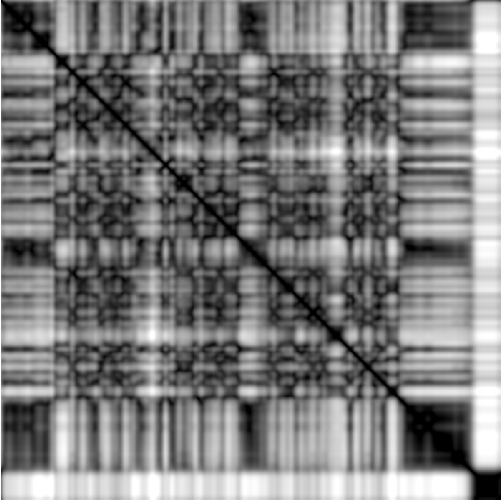15. Die Krähe. (The Crow)

Variiertes Strophenlied in c-Moll mit drei Strophen. [more]
Normalized variant of the well-known MFCC features (3 sec), the low bands are loosely correlated to timbre. [more]
Singer: Gerhard Hüsch (Baritone), Piano: Hanns-Udo Müller. Recorded on vinyl, April-September 1933.
Source, License: EA Terms of Use
Information about our segmentation of »15. Die Krähe«
Variiertes Strophenlied in c-Moll mit drei Strophen.
Es lässt sich eine dreiteilige Form erkennen: ABA' mit einem instrumentalen Vor- und Nachspiel (I A1 A2 | B | A1 A3 I2 in der Feinsegmentierung).
Die dreiteilige Struktur stimmt mit der Stropheneinteilung überein.
Das instrumentale Vorspiel I stimmt in den ersten vier Takten mit der Strophe A1 überein, wobei die Gesangsmelodie von der rechten Hand des Klaviers übernommen wird.
A2 stellt eine leichte Variation von A1 dar.
In B wechselt trotz gleicher Art von Begleitung die Stimmung: Dur statt Moll.
In A3 wird A1 sowohl bzgl. der Harmonik als auch bzgl. der Melodik stark variiert.
Das Nachspiel I2 stellt eine leichte Variation des Vorspiels I dar.
Lyrics: Project Gutenberg
MFCC (Mel Frequency Cepstral Coefficients)
This feature was originally developed for speech analysis and speaker recognition. After transforming a musical signal in a spectrogram representation, MFCC-based features are computed by combining suitable frequency bands into percepually inspired Mel bands and applying a decorrelating discrete cosine transformation. Especially, the lower MFCC bands describe the coarse form of the spectral envelope which correlates to timbre. For deriving MFCC-ENS features (MFCC Energy Normalized Statistics), these MFCC features are quantized, smoothed (in temporal direction), and normalized with respect to the ℓ2-norm.
Furthermore, we present a novel variant of MFCC-ENS features by prior weighting the spectrogram by the second derivative of the spectral phase information in the time domain. This indicates slight changes in pitch which typically occur in vocals and which are not present in piano music. Especially the harmonics of piano-played notes are attenuated by this method which leads to smaller spectral envelopes in the piano sections and hence to more discriminative timbre-related MFCC features.
Literature
- Steven Davis, Paul Mermelstein: Comparison of parametric representations for monosyllabic word recognition in continuously spoken sentences, Readings in Speech Recognition 1990, pp. 65–74.
- Hiroko Terasawa, Malcolm Slaney, Jonathan Berger: The thirteen colors of timbre, WASPAA 2005, pp. 323–326.
- Dirk v. Zeddelmann, Frank Kurth: A construction of compact MFCC-type features using short-time statistics for applications in audio segmentation, EUSIPCO 2009, pp. 1504–1508.
